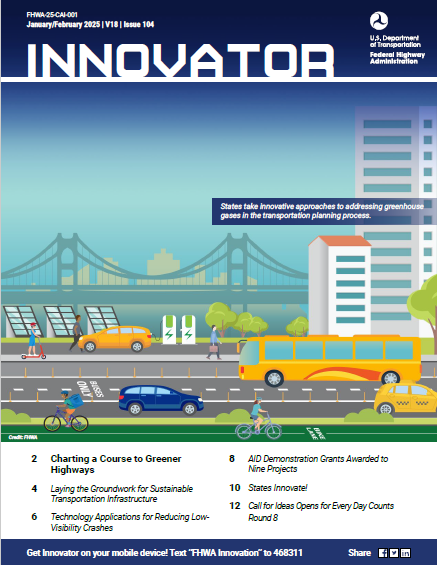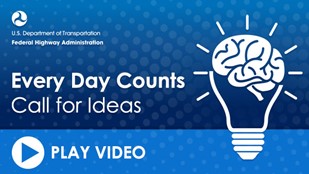January 23, 2025
Innovation of the Month - Weather-Responsive Management Strategies
Adverse road weather conditions are present during nearly 14 percent of fatal crashes in the United States, representing almost 72,000 fatal crashes from 2013 to 2022. Approximately five percent of motor vehicle crashes during that time occurred during low-visibility conditions. Fog or other weather conditions can lead to sudden stops and slowdowns on the road, situations where drivers may struggle to respond in enough time to avoid colliding with other vehicles.
In Virginia, frequent incidents of dense fog led the Virginia Department of Transportation (VDOT) to explore effective ways to keep motorists safer. Interstate 77 is a rural, mountainous freeway that serves as a major thoroughfare in the southwestern part of the State. Due to mountainous nature of the roadway, there can be significant altitude differences between north and southbound traffic.
Dense fog creates dangerous driving conditions in this location 29 days per year, on average. The low-visibility conditions can lead to chain-reaction rear-end crashes. In March 2013, one such event included 95 cars and resulted in three fatalities. The overall crash rate during these foggy conditions is more than double that of clear conditions.
Traditional countermeasures had a limited effect on crashes, so VDOT pursued a variable speed limit (VSL) system to lower the speed of motorists during dense fog events. VDOT’s effort highlights the importance of agencies working with State legislatures when needed. The Virginia legislature provided additional authority to VDOT to use VSLs before implementing this innovation.
VDOT developed an algorithm to estimate safe speeds based on visibility and implemented the system of signs, closed-circuit cameras, and sensors along a 12-mile section of the Fancy Gap corridor for approximately $7.5 million.
After implementation, speeds have come down about 5-6 mph on average during these events and VDOT reports nearly a 75 percent reduction in crashes.
The Weather-Responsive Management Strategies (WRMS) initiative promotes VSL and other low-visibility countermeasures to support traffic and maintenance management strategies during low-visibility conditions. The goal is to improve safety and reliability, as well as to reduce the environmental impacts on the transportation system from adverse weather.
To learn more about VDOT’s VSL program, read this article from the January/February issue of Innovator. To learn more about other WRMS technologies, please contact David Johnson, FHWA Office of Operations.
Call for Ideas Opens for Every Day Counts Round 8
FHWA is seeking suggestions for market-ready innovations to deploy in 2026 as part of the eighth round of Every Day Counts (EDC-8). The agency is encouraging State, local, Tribal, and industry partners, as well as the public, to submit innovative technologies or practices that can enhance safety for all road users and expedite the project delivery process. The deadline for submissions is February 4, 2025. Watch video here.Visit the EDC webpage for information on how to submit suggestions.
Are You Interested in Value Capture but Aren't Sure Where to Start?
In 2019, EDC-5 promoted an innovative way to derive monetary value from transportation improvements to help offset the cost of their implementation- Value Capture. FHWA offers tools like the value capture implementation manual to help State and local agencies determine if this method is for them and where to start.
Another important tool for any agency considering implementing value capture is the value capture frequently asked questions webpage. This page provides information on 14 different value capture techniques under three groups- cost sharing strategies, capture of project benefits strategies, and capture value from publicly owned facility strategies.
Each featured technique FAQ includes details that can give your agency a solid knowledge base from which to make informed decisions on how to proceed. These include technique background, similarities and differences to other techniques, when and where they can be used, advantages and disadvantages, and other implementation information.
New Innovator Now Available

The January/February issue of Innovator is now available, accessible from your computer, tablet, or mobile phone to optimize your reading experience!
In this issue:
- Call for Ideas for Every Day Counts Round 8
- Technology Applications for Reducing Low-Visibility Crashes
- AID Demonstration Grants Awarded to Nine Projects
- And more...
Comments? Questions? We'd love your feedback! Drop us a line and let us know what you think.
Read past issues and sign up to receive Innovator by email here, or text "FHWA Innovation" to 468311 to get Innovator on your smartphone.
Stay Up to Date on the EDC Innovations That Interest You Most

EDC teams are always on the move! If you blink, you could miss out on important webinars, case studies, tools, videos, and more. To never miss information for the EDC innovations that interest you most, visit the subscription page and select the topics you’d like to receive updates on directly from the teams that coordinate them.
Recent bulletins:
NextGen TIM 1/22/25
DBE for Design Build 1/21/25
Local Aid Support 1/16/25
UHPC 1/15/25
Innovation in Project Delivery 1/15/25
EPDs 1/14/25
NextGen TIM 1/8/25
Comments? Questions?
We’d love your feedback! Drop us a line and let us know what you think.
Upcoming Events
About EDC
Every Day Counts, a State-based initiative of the Federal Highway Administration's Office of Innovation and Workforce Solutions, works with State, local, and privatesector partners to encourage the adoption of proven and underutilized technologies to deliver transportation projects more efficiently, enhance safety forall users, support a sustainable and resilient infrastructure, and incorporate equity inproject planning and delivery.
EDC News is a weekly publication highlighting successful EDC innovation deployments across the country.
EDC News is published weekly by the FHWA Center for Accelerating Innovation.
Disclaimer: The U.S. Government does not endorse products or manufacturers. Trademarks or manufacturers’ names appear in this document only because they are considered essential to the objective of the document. They are included for informational purposes only and are not intended to reflect a preference, approval, or endorsement of any one product or entity.
Except for the statutes and regulations cited, the contents of this document do not have the force and effect of law and are not meant to bind the States or the public in any way. This document is intended only to provide information regarding existing requirements under the law or agency policies.
Recommended Citation:
U.S Department of Transportation, Federal Highway Administration
EDC News, January 23, 2025
Washington, DC



